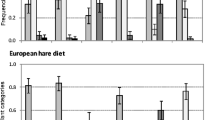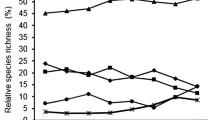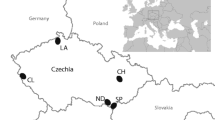Abstract
Wild ungulates like the guanaco are exposed to important changes in climate and plant diversity along altitudinal gradients in the Andes Mountains, such as in the Southern Andean Precordillera where three phytogeographic provinces are present in altitudinal belts. The guanaco’s diet and food availability were seasonally analyzed using microhistological analysis and point-quadrat transects at six sampling sites, representative of the phytogeographic belts along the altitudinal gradient. Plant cover and diversity decreased with growing altitude. Richness of plant species was poorer at the summit than in the lower altitudes, whereas the proportion of species eaten by guanacos increased with altitude. The diet included 77 species. Grasses were preferred and shrubs were avoided all year round. The grass Poa spp. occupied more than 50 % of the diet at all altitudes. Grasses were the main dietary item even at low altitudes, where shrubs constituted the main food available. Decreasing generalism with descending phytogeographic belts agrees with the prediction for altitudinal gradients. The increase of diversity in the diet during the winter decline of plant cover at high and middle altitudes follows that expected from the optimal foraging theory. The winter decline of vegetation and the dietary shift from grazing to browsing proved to be stronger as altitude increases and the climate become more rigorous. Plant species richness, food scarcity, and climate severity are relevant variables to explain altitudinal and seasonal changes in the diet of adaptive ungulates in mountain environments, such as the guanaco in the Southern Andean Precordillera.



Similar content being viewed by others
References
Abbas F, Morellet N, Hewison AJ, Merlet J, Cargnelutti B, Lourtet B, Angibault JM, Daufresne T, Aulagnier S, Verheyden H (2011) Landscape fragmentation generates spatial variation of diet composition and quality in a generalist herbivore. Oecologia 167:401–411
Alipayo D, Valdez R, Holechek JL, Cardenas M (1992) Evaluation of microhistological analysis for determining ruminant diet botanical composition. J Range Manage 45:148–152
Ambrosetti JA, Del Vitto LA, Roig FA (1986) The vegetation of the “Paso de Uspallata”, Province Mendoza, Argentina. Veröff Geobot Inst ETH 91:141–180
Baldi R, Pelliza Sbriller A, Elston D, Albon SD (2004) High potential for competition between guanacos and sheep in Patagonia. J Wildl Manage 68:924–938
Baumgartner LL, Martin AC (1939) Plant histology as an aid in squirrel food-habit studies. J Wildl Manage 3:266–268
Bolker B (2007) Ecological models and data in R. Princeton University Press, Princeton
Cabral D (2009) Plantas nativas de Mendoza. www.floramendocina.com.ar/fichas. Accessed 10 May 2013
Capitanelli R (1971) Climatología de Mendoza. Univ Nac Cuyo, Mendoza
Carothers JH, Jaksic FM, Marquet PA (1996) A model for species distributions along a gradient: lizards as study systems. Rev Chil Hist Nat 69:301–307
Colwell RK, Futuyma DJ (1971) On the measurement of niche breadth and overlap. Ecology 52:567–576
Daget P, Poissonet J (1971) Une méthode d’analyse phytologique des prairies. Critéres d’application. Ann Agron 22:5–41
Dalmasso AD, Martínez Carretero E, Videla F, Puig S, Candia R (1999) Reserva natural Villavicencio, Mendoza, Argentina: Plan de Manejo. Multequina 8:11–50
De Fina A (1992) Aptitud Agroclimática de la Argentina. Acad Nac Agron Vet, Buenos Aires
Diblasi A, Bowman AW (2001) On the use of the variogram for checking independence in a Gaussian spatial process. Biometrics 57:211–218
Duncan C, Chauvenet ALM, McRae LM, Pettorelli N (2012) Predicting the future impact of droughts on ungulates populations in arid and semi-arid environments. PlosOne 7:1–9. doi:10.1371/journal.pone.0051490
Erschbamer B, Mallaun M, Unterluggauer P (2006) Plant diversity along altitudinal gradients in the southern and central Alps of south Tyrol and Trentino (Italy). Gredleriana 6:47–68
Franklin WL (1982) Biology, ecology, and relationship of man to the South American camelids. In: Mares MA, Genoways HH (eds) Mammalian biology in South America. Pymatuning Laboratory of Ecology, University of Pittsburg, Pittsburg, pp 457–487
Franklin WL, Puig S (2014) Guanaco feeding strategies: an analysis by ecoregions and forage types af an extraordinary adaptive and digestively efficient herbivore. In Franklin W.L. (ed.) Guanaco ecology and conservation, (in press)
Gentry AH (1988) Changes in plant community diversity and floristic composition on environmental and geographical gradients. Ann Missouri Bot Gard 75:1–34
Grytnes JA, Vetaas OR (2002) Species richness and altitude: a comparison between null models and interpolated plant species richness along the Himalayan altitudinal gradient. Nepal Am Nat 159:294–304
Harrington JH (1971) Descripción geológica de la Hoja 22c, “Ramblón”, provincias de Mendoza y San Juan. Dir Nac Geología y Minería, Buenos Aires. Boletín 114:1–87
Hidalgo LG, Cauhepe MA, Erni AN (1998) Digestibilidad de materia seca y contenido de proteína bruta en especies de pastizal de la Pampa deprimida, Argentina. Investigaciones Agrarias: Producción y Sanidad Animal 13:165–177
Holechek JL (1982) Sample preparation techniques for microhistological analysis. J Range Manage 35:267–268
Holechek J, Gross B (1982) Evaluation of different calculation procedures for microhistological analysis. J Range Manage 35:721–723
Holeckek JL, Valdez R (1985) Magnification and shrub stemmy material influence on fecal analysis accuracy. J Range Manage 38:350–352
Jacobs J (1974) Quantitative measurement of food selection. Oecologia 14:413–417
Körner C (2000) Why are there global gradients in species richness? Mountains might hold the answer. Trends Ecol Evol 15:513–514
Kowalczyk R, Taberlet P, Coissac E, Valentini A, Miquel C, Kamiński T, Wójcik JM (2011) Influence of management practices on large herbivore diet: case of European bison in Bialowieza Primeval Forest (Poland). Forest Ecol Manage 261:821–828
Kuijper DPJ, Ubels R, Loonen MJJE (2009) Density dependent switches in diet; a likely mechanism for negative feedbacks on goose population increase? Polar Biol 32:1789–1803
Landman M, Kerley GIH (2001) Dietary shifts: do grazers become browsers in the Thicket Biome? Koedoe 44:31–36
Launchbaugh KL, Walker JW, Taylor CA (1999) Foraging behavior: experience or inheritance? In: Launchbaugh KL, Mosley JC, Sanders KD (eds) Grazing behavior in livestock and wildlife. University of Idaho, Moscow, pp 28–35
Lehmann D, Mfune JKE, Gewers E, Cloete J, Brain C, Voigt CC (2013) Dietary plasticity of generalist and specialist ungulates in the Namibian Desert: a stable isotopes approach. PlosOne 8:1–10. doi:10.1371/journal.pone.0072190
Linares L, Linares V, Mendoz G, Peláez F, Rodríguez E, Phum C (2010) Food preferences of guanaco (Lama guanicoe cacsilensis) and its competence with cattle in the Calipuy National Reserve, Peru. Scientia Agropecuaria 1:225–234
Martínez O, Rechberger J (2007) Características de la avifauna en un gradiente altitudinal de un bosque nublado andino en La Paz, Bolivia. Rev Peru Biol 14:225–236
Muñoz AE, Simonetti JA (2013) Diet of guanaco in sheep-free rangeland in Tierra del Fuego, Chile. Cien Inv Agr 40:185–191
Neu CW, Byers CR, Peek JM (1974) A technique for analysis of utilisation-availability data. J Wildl Mgmt 38:541–545
Pellissier L, Fiedler K, Ndribe C, Dibuis A, Pradervand JN, Guisan A, Rasmann S (2012) Shifts in species richness, herbivore specialization, and plant resistance along elevation gradients. Ecol Evol 2:1818–1825
Pfister JA (1999) Behavioral strategies for coping with poisonous plants. In: Launchbaugh KL, Mosley JC, Sanders KD (eds) Grazing behavior in livestock and wildlife. University of Idaho, Moscow, pp 45–59
Polanski J (1954) Rasgos geomorfológicos del territorio de la provincia de Mendoza. Ministerio de Economía, Instituto de Investigaciones Económicas y Tecnológicas. Cuaderno de Investigaciones y Estudios 4:4–10
Puig S, Videla F, Monge S, Roig V (1996) Seasonal variations in guanaco diet (Lama guanicoe Müller 1776) and in food availability in Northern Patagonia, Argentina. J Arid Environ 34:215–224
Puig S, Videla F, Martínez Carretero E, Dalmasso A, Durán V, Cortegoso V, Lucero G, Carminati A, Moreno D (2008) Plan de Manejo para la Reserva Villavicencio, período 2009–2013. IADIZA-FVSA-UNCuyo. Technical Report, p 263
Puig S, Rosi MI, Videla F, Mendez E (2011) Summer and winter diet of the guanaco and food availability for a High Andean migratory population (Mendoza, Argentina). Mamm Biol 76:727–734
Puig S, Videla F, Rosi MI (2014) Seasonal distribution and habitat selection by the guanaco (Lama guanicoe) along an altitudinal gradient in the Southern Andean Precordillera (Argentina), (in press)
Raedeke KJ, Simonetti JA (1988) Food habits of Lama guanicoe in the Atacama desert in northern Chile. J Mammal 69:198–201
Roig FA (1993) Aportes a la etnobotánica del género Prosopis. In: IADIZA (ed), Contribuciones Mendocinas a la Quinta Reunión de Regional para América Latina y el Caribe de la Red de Forestación del CIID. IADIZA-CRICYT-CIID, Mendoza, Argentina, pp 99–119
Roig FA (1994) La Provincia del Cardonal. In: Botánica y Fitosociología, IADIZA (ed) La vegetación de los Andes centrales de Argentina: Excursión botánica, pp 19–24
Roig FA, Martínez Carretero E (1998) La vegetación puneña en la provincia de Mendoza, Argentina. Phytocoenologia 28:565–608
Rojas I, Becerra P, Gálvez N, Laker J, Bonacic C, Hester A (2011) Relationship between fragmentation, degradation and native and exotic species richness in an Andean temperate forest of Chile. Gayana Bot 68:163–175
Siegel S, Castellan NJ (1988) Nonparametric statistics for the behavioral sciences, 2nd edn. McGraw-Hill, New York
Smith AD, Shandruk LJ (1979) Comparison of fecal, rumen and utilization. Methods for ascertaining pronghorn diets. J Range Manage 32:275–279
Stafford Smith M (1996) Management of rangelands: paradigms at their limits. In: Hodgson J, Illius A (eds) The ecology and management of grazing systems. CAB International, Wallingford, pp 325–358
Stephens DW, Krebs JR (1986) Foraging theory. Princeton University Press, Princeton
Terborgh J (1977) Bird species diversity on an Andean elevational gradient. Ecology 58:1007–1019
Van Soest PJ (1996) Allometry and ecology of feeding behavior and digestive capacity in herbivores: a review. Zoo Biology 15:455–479
Videla MA, Suárez J (1991) Mendoza Andina: Precordillera y Alta Cordillera, Mendoza, Argentina. Adalid, Mendoza
Wainstein P, González S (1962) Valor forrajero de trece especies de Stipa de Mendoza. Rev Fac Cs Agrarias Univ Nac Cuyo 9:3–18
Weckerly FW, Kennedy ML (1992) Examining hypotheses about feeding strategies of white-tailed deer. Canadian J Zool 70:432–439
Zar JH (1984) Biostatistical analysis, 2nd edn. Prentice-Hall Inc., Upper Saddle River
Zweifel-Schielly B, Kreuzer M, Ewald KC, Suter W (2009) Habitat selection by an Alpine ungulate: the significance of forage characteristics varies with scale and season. Ecography 32:103–113
Acknowledgments
We are grateful for the kind hospitality and assistance in fieldworks to S. Giudici (responsible for the Villavicencio protected area) and to the ranger team of the Villavicencio Reserve (DRNR, Mendoza). We thank A. Diblasi and M. Mosca Torres for their contribution on improving the statistical analyses, N. Horak for her assistance in the English translation, and MI Cona for her enriching suggestions on the manuscript. We thank D.P.J. Kuijper, the anonymous reviewer, and the editor for their valuable suggestions. This study was supported by the National Council of the Scientific and Technical Researches of Argentina through a research grant (PIP 239).
Author information
Authors and Affiliations
Corresponding author
Additional information
Communicated by: Karol Zub
Rights and permissions
About this article
Cite this article
Puig, S., Rosi, M.I., Videla, F. et al. Food selection by the guanaco (Lama guanicoe) along an altitudinal gradient in the Southern Andean Precordillera (Argentina). Acta Theriol 59, 541–551 (2014). https://doi.org/10.1007/s13364-014-0191-z
Received:
Accepted:
Published:
Issue Date:
DOI: https://doi.org/10.1007/s13364-014-0191-z




